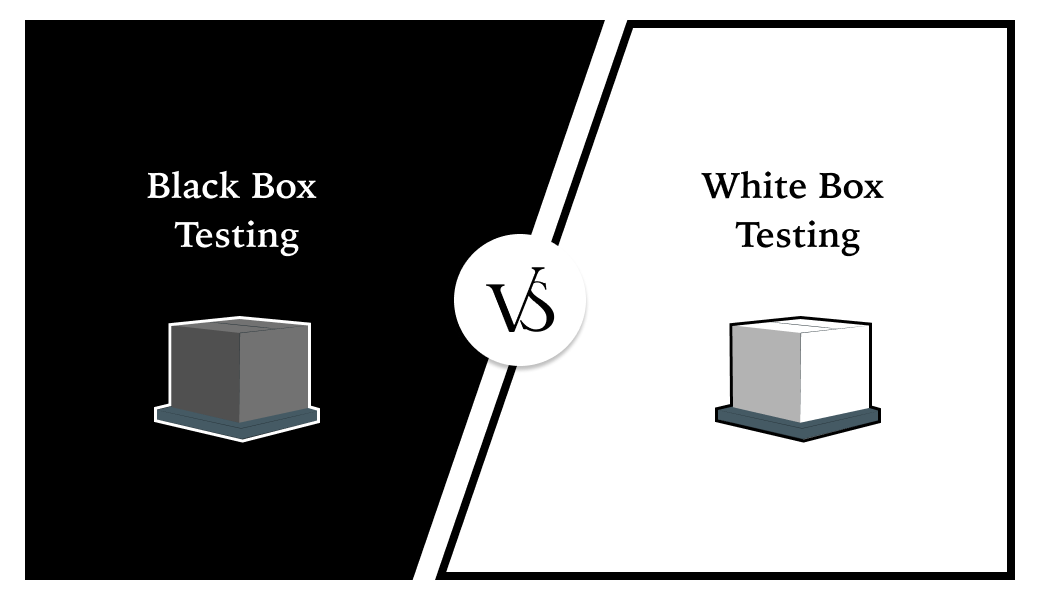Black box testing is a software testing methodology in which the tester analyzes the functionality of an operation without a thorough knowledge of its internal design. Again, in white box testing, the tester is knowledgeable of the internal design of the operation and analyzes it during testing.
The term black box symbolizes a black external covering of the operation, precluding testers from seeing its inner workings and compelling them to examine only the end-consumer experience. Likewise, the term white box signifies the operation’s translucency, allowing the tester to see through the external box and into the inner law.
Let’s examine the three primary distinctions between the two software testing approaches.
Process
Black Box Testing
– The black box testing procedure promotes a rigorous and comprehensive approach to operation analysis. The thing is quality assurance for the end user.
– The process begins with the testing platoon understanding the demand statement of the operation. This step generally requires the presence of a well-proved software demand specification.
– Testing methodologies similar to parity partitioning and boundary value analysis are used to determine sets of valid inputs and their prognosticated labor.
– This information is also used to make test cases, which are also run to check whether they’re successful or not.
– The factual issues are compared against the intended issues, and failed test cases are classified as bugs or blights.
– These bugs are reported to the development platoon, who also work on fixing them.
– Once the inventors modernize the operation, the testing platoon retests the preliminarily reported problem areas and checks if they’ve been fixed.
White box Testing
– The white box testing process is much further ‘surgical’ than black box testing and far more effective on lower targets. The thing is to assess all the possible cases and scripts for the target, which is frequently a ‘too-critical-to-fail’ operation, element, or functionality.
– The first step is relating the target to the element, point, or operation to be tested. By choosing a narrow target, white box testers can be thorough and insure indefectible functionality. This is generally achieved by picking the lowest possible logical module, working on it, and also moving on to the coming bone.
– Of course, one can also execute white box testing on larger systems; still, this is frequently a resource- ferocious process and should only be done if the need is lesser than the trouble.
– The coming step is creating an inflow graph by conniving all possible scripts. This helps determine the compass of the testing exercise and write applicable test cases. Scripts must regard user peregrinations, program specifications, use cases, specialized specifications, and pseudocode.
– Once the inflow graph is set, all the paths the trip might take must be counterplotted for testing and framed as test cases.
– Eventually comes the prosecution phase, where the testing is completed, and any issues are recorded for fixing.
Techniques
Black Box Testing
– Parity partitioning Also known as parity class partitioning( ECP), this black box testing fashion calls for the input values for the operation or system to be classified grounded on outgrowth similarity.
– This enables testing brigades to use only one value from within the class or group for assaying the outgrowth rather than having to review all the applicable input values from the group. This fashion maintains test content, and the quantum of rework needed and time spent are minimized.
– State transition testing In this fashion, the tester analyzes the colorful countries of the operation, which change as per events or conditions that the operation is subordinated to. Each event triggers a state that’s also treated as a script to be tested.
– This fashion is handy for simple scripts, while more complex scripts will produce complicated transition plates and make the fashion less effective.
– Experience-grounded testing Guessing the crimes that might arise in the operation is a crucial illustration of this fashion. Then, the testing platoon leverages its experience around the operation’s gestures and its functionalities to find the areas prone to crimes.
– Exemplifications of guessing grounded on experience include searching for common crimes, similar to dividing by zero, handling null values in textbook fields, and accepting blank inputs where they shouldn’t be allowed.
– Graph-grounded testing All operations are created using objects. This system identifies the objects, and an ‘object graph’ is created. This graph is used to identify all object connections, write test cases, and test for error discovery.
– Comparison testing: Eventually, in this fashion, independent performances of one operation are compared to each other during the testing process.
White Box Testing
The below-listed ways are used in white box testing
– Statement content All statements are at least formerly executed at the source law position in this white box testing approach. The number of statements executed is recorded.
– This fashion allows the testing platoon to dissect the source law and set prospects around what it can and cannot do. It’s also dependable for checking law quality and vindicating path inflow. Still, one cannot use it to test false conditions.
– This system tests the internal coding and structure of the software. It can be carried out by programmers and is suitable for Drupal specialists.
– Decision content In this fashion, decision content is given to Boolean values, and Boolean expressions ’ true and false results are reported.
– Control inflow statements that produce a possibility of two or further issues, similar to ‘ do while ’, ‘ if ’, and ‘ case ’, is considered as ‘ decision points ’ in this fashion as they can lead to two issues either true or false.
– This fashion covers all the possible results of every Boolean condition within the law through control inflow maps and graphs. still, it can occasionally be delicate to achieve complete content due to the actuality of complicated expressions.
– Branch content This fashion covers all branches of the control inflow graph. Each decision point condition’s possibly true and false issues are covered at least formerly. This system guarantees that the several branches of each decision point are executed successfully.
– Multitudinous styles are available for calculating branch content, the most common of which is pathfinding. This system uses the number of executed branch paths to calculate branch content. inventors can substitute decision content with branch content.
– Condition content In this fashion, the testing platoon analyzes all the tentative expressions in an operation for every possible outgrowth. All the conditions are tested singly, and all the possible results of every condition are tested at least formerly. Predicate content is another name for this fashion.
– Multiple condition content In this fashion, all the possible permutations of condition issues in every decision, as well as all entry points, are tested at least formerly. Full multiple-condition content generally requires a high number of test cases.
– Path content All program paths are tested in this comprehensive fashion. It’s abused to insure that every operation path is employed at least formerly. This fashion is generally useful for testing complex programs.
– Control inflow testing This fashion determines the sequence in which an operation’s statements or instructions are executed via a control structure. The test cases of the anatomized operation are developed using the control structure. Control inflow testing is generally used during unit testing.
– Testers, using this fashion, elect a specific part of the operation for setting the testing path. The control inflow graph is created from the edge, knot, junction knot, and decision knot to outline all the possible prosecution paths.
– Data inflow testing Eventually, white box testers use this fashion to dissect the control inflow of programs to explore the variable sequence grounded on the event sequence. During testing, the focus lies on two points where values are assigned to the variables and where these values are used.
– In this fashion, the control inflow graph is used to descry logical inconsistencies that disrupt data inflow. Reasons for anomaly discovery include variables being used without initialization and initialized variables not being used.
Operations
Black Box Testing
– The main thing of black box testing is to insure the system works faultlessly for the end user.
– The base of black box testing is erected on external hypotheticals. The tester doesn’t take into consideration the beginning of the operation.
– This testing methodology suits advanced- position testing conditioning, including acceptance and system testing.
– The testing platoon need not have in-depth knowledge of programming to execute this testing methodology, nor does it need moxie in perpetration.
– One can not automate black box testing fluently because the testing and programming functions work nearly together.
– The base for test cases is the software demand specification document. Testing generally begins after preparing the demand specification paper and involves the inventor, tester, and end user.
– The methodology is sweeping in nature, fastening on trial and error and a lack of granularity. On the else side, it’s a lower resource- ferocious.
– The source law isn’t penetrated during black box testing, making this an ineffective way of testing algorithms. still, it helps test lengthy portions of the law.
– Testing moxie isn’t obligatory – testers with lower skill situations can still carry out the black box testing of operations, indeed without knowledge of the operating system or programming language.
White Box Testing
– The main thing of white box testing is to insure that an operation’s law scores high in quality and integrity.
– An in-depth understanding of the system’s internal workings serves as the foundation of white box testing. This enables the tester to estimate the functioning and design of the law.
– This testing methodology suits lower-position testing conditioning, including integration and unit testing.
– A working grasp of programming knowledge is needed for white-box testing. The tester must also be knowledgeable about perpetration.
– White box testing is simple to automate.
– The base for test cases is the detailed design document. Once the document is set, testing involves programmers, inventors, and specialist testers.
– This testing methodology is superior in terms of granularity; still, this comes at the cost of advanced resource- intensiveness.
– Inventors can use this total testing style to dissect internal bounds and data disciplines. It’s also well-suited for testing algorithms.
– The QA team accesses the law during white box testing and, as a result, can remove defective or gratuitous lines of law that might serve as arrears in the future. still, the strike of law availability is the pitfall associated with outsourcing – it is possible to steal law during testing.
– Eventually, white box testing requires high situations of experience and expertise.



